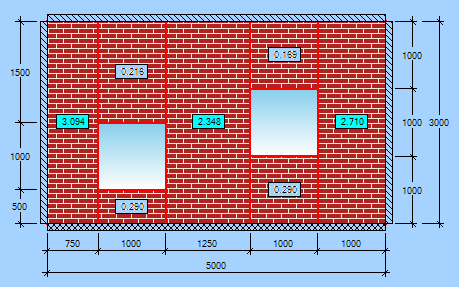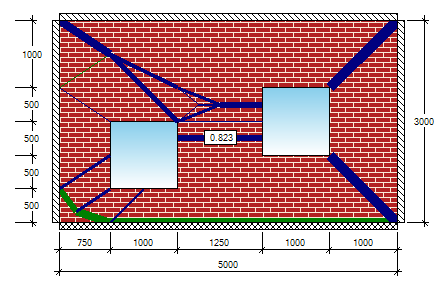MasterSeries Blog
Gain a Competitive Edge in Masonry Design with Advanced Yield-Line Analysis
Engineers have several options available to them when attempting to calculate a masonry walls’ lateral resistance. Common methods of analysis include the flexural strength method, where the wall panel is divided into a series of sub-panels that frame openings. Or the reduced fixity method, where the wall panel is considered to be a solid entity and the fixity reduced along the edges of openings.
But how does our advanced yield lines analysis method stack up against these more traditional routes?
In the following example, we are going to compare the results from the different analysis methods and highlight the competitive advantages of advanced yield-line analysis.
The Scenario
We have a cavity wall panel that measures 5-by-3 meters. The sides and top are pinned, while the bottom edge is fixed.

The inner-leaf is 100 mm wide and made of concrete blocks. The concrete blocks are loaded with a 5 kN/m dead load and 5 kN/m live load.
The outer-leaf is 102.5mm clay brick. The brick has a lateral wind load f 0.75 kN/m2 applied to it.

The Results – Without Openings
Without openings, the utilisation of the wall is 66% with both the traditional and advanced yield analysis methods. So, no difference when there are no openings, but how do the two methods compare when an opening is introduced?
The Results – With Openings
When using the traditional flexural strength method, the capacity of the wall is dramatically reduced, regardless of the orientation of the sub-panels. This results in a utilization ratio greater than 100%, indicating that the design is insufficient.

Approximations and assumptions of the sub-panel method
- Wall panel is divided into individual sub-panels
- The interaction between the sub-panels are neglected
- Edge line loads from opening and connecting sub-panels are converted into an approximate surface load
Next, we repeated the process using the reduced fixity method, however, the utilization ratio is still over 100%.
However, if we use the Advanced Yield-Line Analysis, we can model and calculate the entire wall panel with the openings. This advanced analysis provides us with a great insight into the real behaviour of the structure and shows us the actual yield lines of the wall under the lateral forces.

As a result of the Advanced Yield-Line Analysis, we see that the utilisation of the wall is almost 20% below the 100%, so the wall with the openings is still stable compared to the other traditional approximate methods.
Other Benefits
- Calculating the real behaviour of the wall
- You see the developed yield-lines
- Arbitrary combination of openings even overlapping openings as well
- Unlimited number of openings
- Arbitrary lateral plus vertical point loading
- Accurate consideration of wall reinforcement with wind posts
Explore how MasterSeries Masonry can help you design more economical solutions and boost your productivity.
Try it for yourself with a free 14-day trial.
Categories
- About
- Beam Designer
- BIM
- Composite design
- Concrete Design
- Connections
- Dynamic
- Educational
- General
- LCA
- Masonry
- MasterFrame
- Pile Cap
- Portals
- PowerPad
- Retaining wall
- Steel Design
- Webinar
- Wind Analysis
